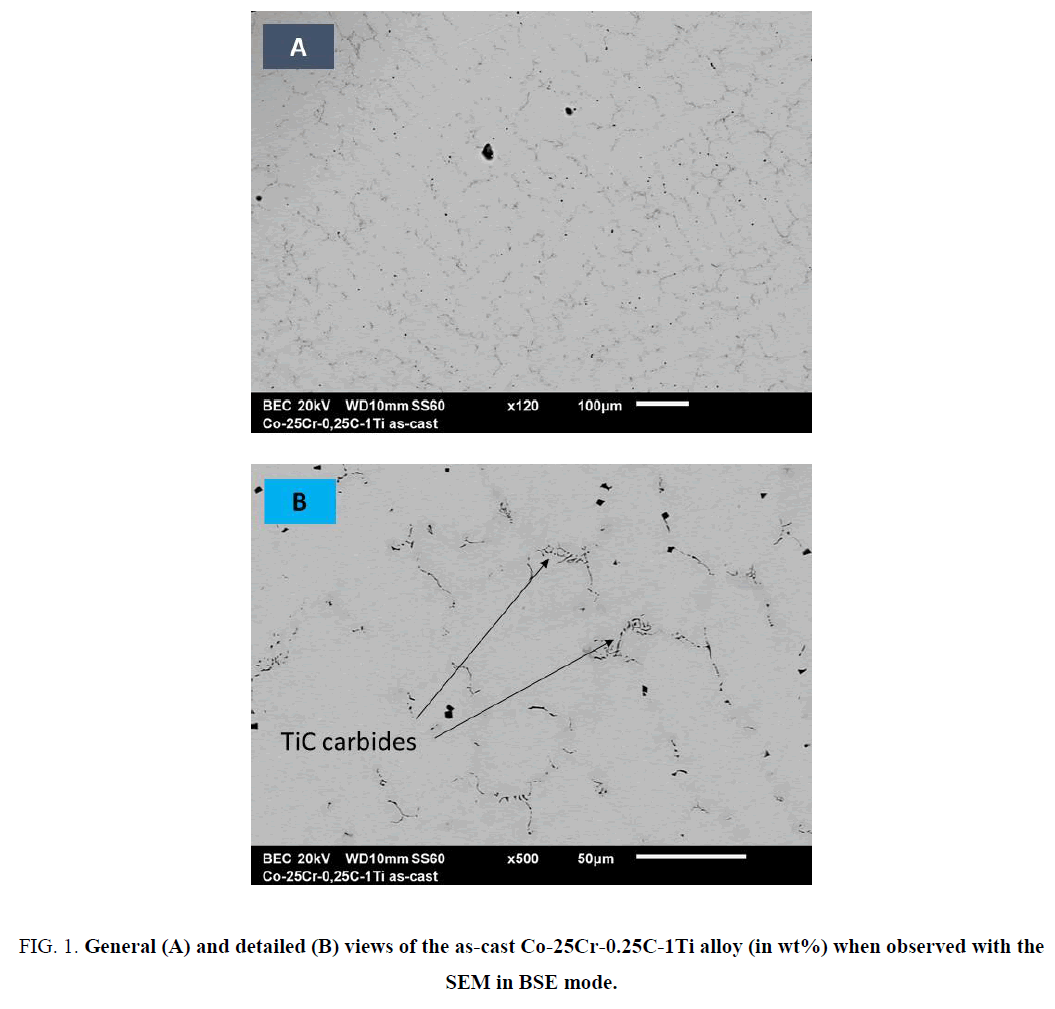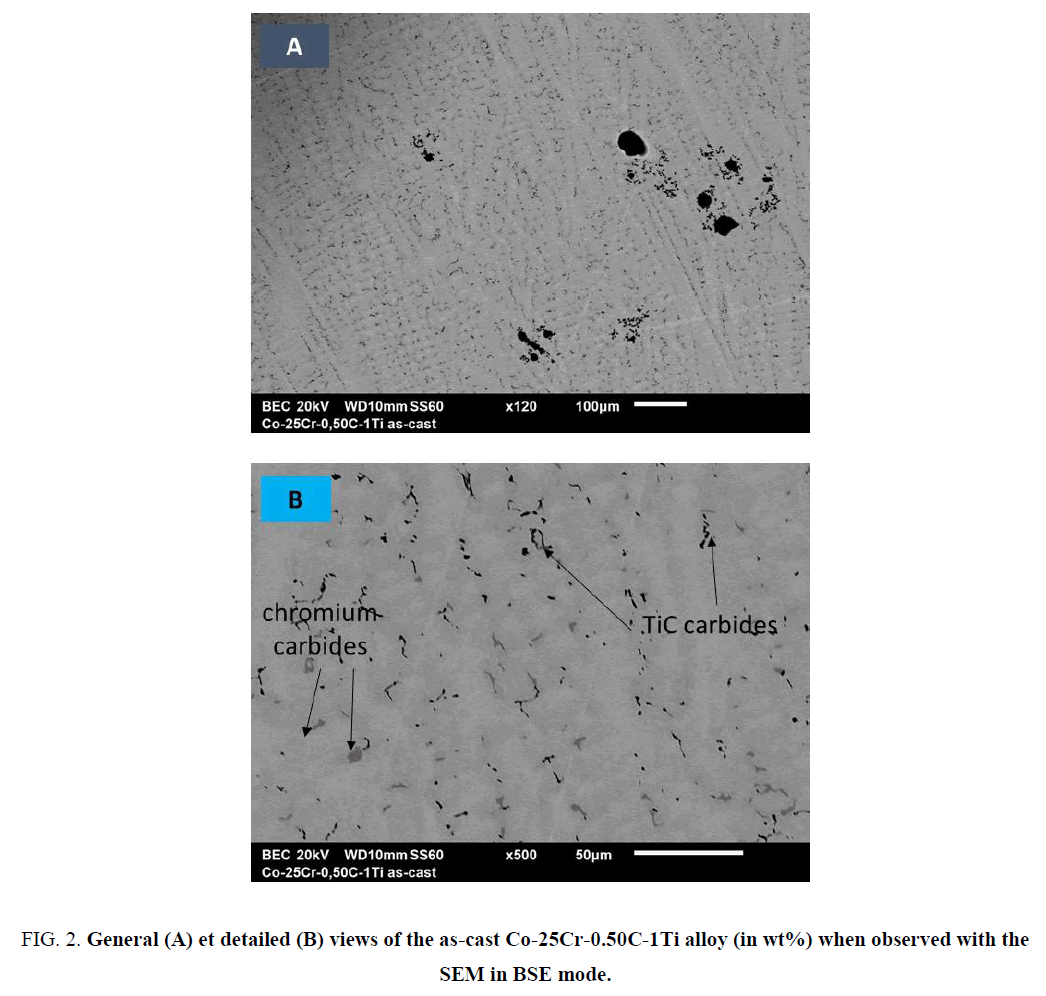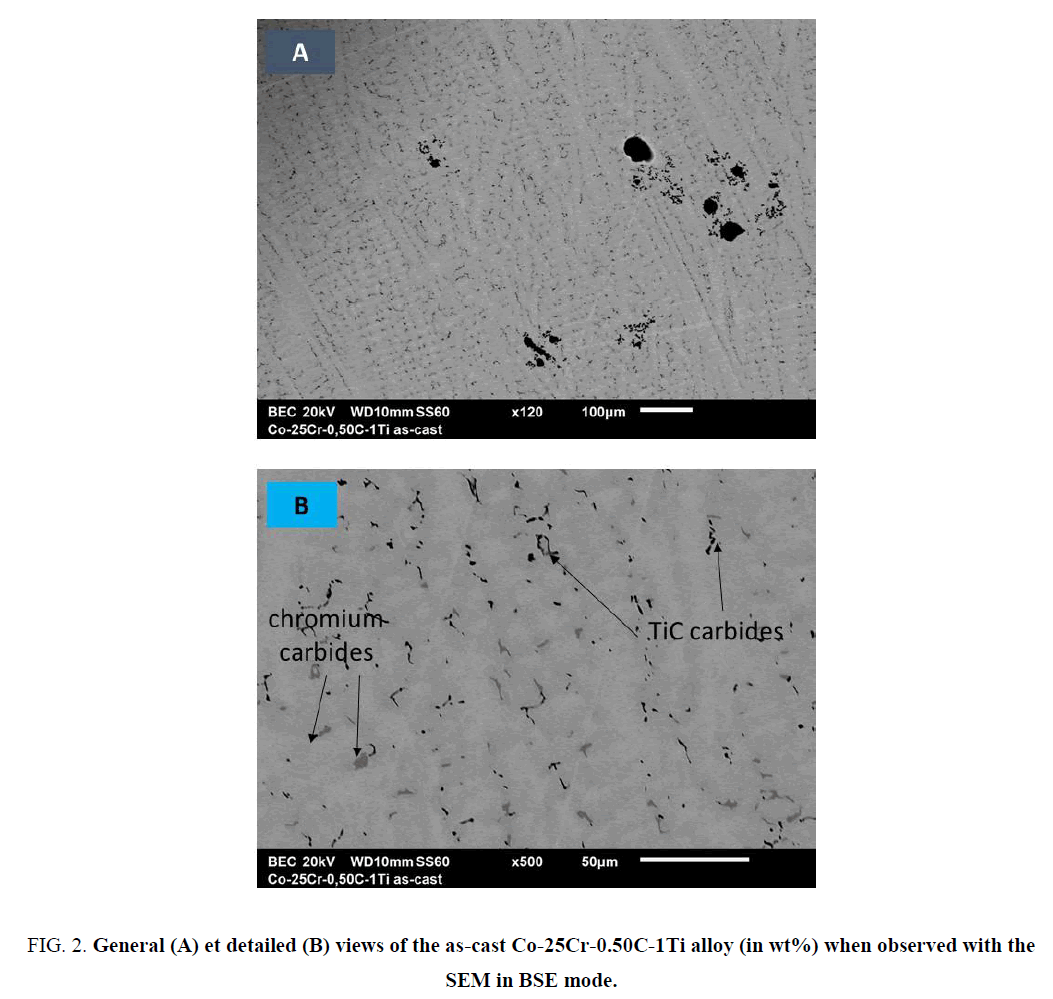Original Article
, Volume: 14( 13)As-Cast Microstructures and Hardness of Chromium-Rich Cobalt-Based Alloys Reinforced by Titanium Carbides
- *Correspondence:
- Berthod P, Institut Jean Lamour, Department CP2S (Chemistry and Physics of Solids and Surfaces) Research team 206, B.P. 70239, 54506 Vandoeuvre-lès-Nancy, France, Tel: +33-(0)3-87-54-77-77; E-mail: patrice.berthod@univ-lorraine.fr
Received: July 13, 2016; Accepted: August 22, 2016; Published: September 14, 2016
Citation: Khair M, Berthod P. As-Cast Microstructures and Hardness of Chromium-Rich Cobalt-Based Alloys Reinforced by Titanium Carbides. Mater Sci Ind J. 2016;14(13):102.
Abstract
Three cobalt-based alloys containing chromium for good chemical resistance at high temperature and both carbon and titanium in quantities great enough for expecting developing significant TiC network to mechanically reinforce them at high temperature, were synthesized by foundry. This Co-25Cr-0.25C or 0.50C-1Ti or 2Ti (all contents in wt%) were successfully obtained, thanks to the fusion and solidification both in inert atmosphere. The obtained microstructures were composed of a dendritic matrix and of interdendritic carbides, mainly of the TiC composition in the three alloys but chromium carbides are also present, notably in the Co-25Cr-0.50C-1Ti. The titanium carbides are of the script-like morphology and are imbricated with matrix in the interdendritic spaces, seemingly forming a eutectic compound with it. The higher the carbon content, the more numerous the carbides whatever their nature, and the higher the titanium content the more numerous the titanium carbides. The hardness is of about 300Hv10 Kg for the 0.25C-containing alloy and of about 370Hv10 kg for the two 0.5C-containing ones. Some particles looking more or less as titanium carbides are rather titanium carbonitrides Ti(C,N) et the presence of titanium oxides was observed in some locations in the bulk. Obviously the elaboration protocol using commercial argon is not well adapted to the strong tendency of titanium to react with O and N.
Keywords
Cobalt alloy; Titanium carbides; Casting; Inert atmosphere; As-cast microstructure; Hardness; Titanium carbonitrides
Introduction
Beside the famous gamma/gamma prime single-crystalline nickel-based superalloys [1-3], some of the conventionally cast equiaxed superalloys merit to be considered too because it was recently demonstrated that some of them are able of high temperature mechanical [4,5] and chemical [6,7] performances of the same level that Ni-based single-crystals. Notably, the cobalt-based alloy containing eutectic script-like eutectic MC carbides, which are remarkably stable at high temperature almost whatever the M carbide-forming element - Ta, Nb, Hf, Zr… [8] - may offer, for elevated temperatures, high levels of mechanical performance, and eventually of chemical resistance. Such interesting high temperature properties were first noticed with TaC-containing cobalt-based superalloys [9], in the mechanical [10], {molten substances}-induced corrosion [11] or air-oxidation [12] fields. Promising high temperature properties are expected with cobalt-based alloys strengthened by Hafnium(IV) carbides (HfC) [13], in the mechanical field [14] as well as in the oxidation one [15]. Niobium carbides (NbC) were also considered and recently tested in Co alloys [16].
Titanium, which is commonly rather considered as a base-element for light aeronautic alloys [1-3] or orthodontic arch-wires [17] for examples, or which can be used in the nuclear field for its specific behaviour in contact with molten glasses [18,19], can also be considered for the reinforcement of superalloys by exploiting its strong carbide-former character. Lighter than Ta or Zr, more available on earth than Hf, better in high temperature oxidation than Nb, it merits to be tested in this role of MC-former element. This is what was done in this work, with the elaboration by casting of three cobalt-based alloys containing 0.25 wt% to 0.5 wt% C (in the superior average of the carbon range usually adopted for superalloys), 25 wt% Cr for the resistance against both oxidation and corrosion at high temperature, and 1 wt% or 2 wt% Ti in order to obtain either exclusively TiC carbides (0.25 wt% C+1 wt% Ti and 0.50 wt% C+2 wt% Ti) or a mixed population of carbides composed of TiC for a half and of chromium carbides for the second half part.
Experimental
These three alloys (Co-25Cr-0.25C or 0.50C-1Ti or 2Ti, in wt%) were synthesized from pure elements (Co, Cr and Ti from Alfa Aesar, >99.9 wt% purity, C: pure graphite rods from Sigma-Aldrich, >99.99 wt% purity) by melting under inert atmosphere (300 mbars of pure Ar, total impurities (O2, H2O, N2): <5 ppm) using a high frequency induction furnace (CELES). The obtained ingots (about 40 g for each of them, conical geometry with a 20 mm height and a 20 mm base diameter) were cut using a metallographic saw (BUELHER).
A part per alloy was taken near the centre of the ingot to characterize the as-cast microstructure. They were embedded in a cold resin/hardener mixture (ESCIL), ground with successive SiC-containing papers of grade varying from 120 to 1200, ultrasonically cleaned, then polished with a textile disk enriched with 1 μm alumina particles. The obtained mirror-like metallographic samples were examined using a Scanning Electron Microscope (SEM) from JEOL (type JSM-6020LA) in Back Scattered Electrons (BSE) mode to control the microstructures of each of the three alloys. The Energy Dispersion Spectrometry (EDS) device equipping the SEM allowed controlling their chemical composition.
The hardness of the three alloys was specified by Vickers indentation under a load of 10 kg. Ten indentations were carried out per alloy, using a Testwell Wolpert machine. The average value and the standard deviation one were calculated.
Results and Discussion
The as-cast microstructure of the first alloy, the Co-25Cr-0.25C-1Ti one, is illustrated by two SEM/BSE micrographs in Figure 1, one giving a general view (120X) and the second more detailing the microstructure (500X). One can well see on the general view that the microstructure is clearly dendritic and that there are dark particles which appear, in the detailed view, as having a tendency to be script-like shaped. One must notice that there are also rare coarser dark particles (general view). The EDS measurements carried out on three different locations leads to the average contents in Co, Cr and Ti presented in Table 1(C cannot be measured by this technique: too light element and with content too low). Globally the targeted composition was effectively obtained.
Figure 1: General (A) and detailed (B) views of the as-cast Co-25Cr-0.25C-1Ti alloy (in wt%) when observed with the SEM in BSE mode.
| 0.25C-1Ti | Co(wt%) | Cr(wt%) | Ti(wt%) |
|---|---|---|---|
| Average | 73.60 | 25.59 | 0.83 |
| SD | 0.53 | 0.42 | 0.11 |
Table 1: Chemical composition of the Co-25Cr-0.25C-1Ti alloy.
The as-cast microstructures of the Co-25Cr-0.50C-1Ti alloy is displayed in Figure 2, with two SEM/BSE micrographs again (general view at 120X, more detailed one at 500X). The dark particles are significantly more numerous (and the coarse dark particles too). The ones that one can think as being carbides reveal here too the dendritic character of the matrix. At the highest magnification, except the coarse globular particles, the dark (black) particles seems being TiC, as suggested by their tendency to the script-like. Other particles are present, a little clearer: they are maybe the chromium carbides that were expected since there is twice more carbon atom than titanium atoms in this alloy. The chemical composition is here too consistent with the targeted one (Table 2).
Figure 2: General (A) et detailed (B) views of the as-cast Co-25Cr-0.50C-1Ti alloy (in wt%) when observed with the SEM in BSE mode.
| 0.5C-1Ti | Co(wt%) | Cr(wt%) | Ti(wt%) |
|---|---|---|---|
| Average | 73.27 | 25.87 | 0.86 |
| SD | 0.06 | 0.08 | 0.03 |
Table 2: Chemical composition of the Co-25Cr-0.50C-1Ti alloy.
The third alloy, Co-25Cr-0.50C-2Ti, is also dendritic, and contains a lot of TiC carbides ( Figure 3A), the script-like morphology is more developed than in the two other alloys ( Figure 3B). Many coarse dark particles are also present. A few chromium carbides can be also noticed. Here too, the desired chemical composition was almost obtained (Table 3).
Figure 3: General (A) et detailed (B) views of the as-cast Co-25Cr-0.50C-2Ti alloy (in wt%) when observed with the SEM in BSE mode.
| 0.5C-2Ti | Co(wt%) | Cr(wt%) | Ti(wt%) |
|---|---|---|---|
| Average | 72.31 | 25.82 | 1.87 |
| SD | 0.32 | 0.40 | 0.12 |
Table 3: Chemical composition of the Co-25Cr-0.50C-2Ti alloy.
Spot EDS analysis was realized in several locations in the matrix to know the chemical composition of this phase. The results are given in Table 4. The main part of chromium is logically present in solid solution in the matrix of the alloys but several weight per cent of this element is lacking, this can be explained by the presence of some chromium carbides. About 0.3 wt% in Ti is also present in the matrix for the 1 wt% Ti – containing alloys but almost three times this value is found in the matrix of the 2 wt% Ti – containing one. There is obviously more competition between chromium and titanium to form carbides than in Ta-containing or Hf-containing chromium-rich cobalt-based alloys, even if this is titanium which captures more carbon to form carbides.
| 0.25C-1Ti | Co(wt%) | Cr(wt%) | Ti(wt%) |
|---|---|---|---|
| Average | 73.60 | 25.59 | 0.83 |
| SD | 0.53 | 0.42 | 0.11 |
| 0.5C-1Ti | Co(wt%) | Cr(wt%) | Ti(wt%) |
| Average | 73.27 | 25.87 | 0.86 |
| SD | 0.06 | 0.08 | 0.03 |
| 0.5C-2Ti | Co(wt%) | Cr(wt%) | Ti(wt%) |
| Average | 72.31 | 25.82 | 1.87 |
| SD | 0.32 | 0.40 | 0.12 |
Table 4: The chemical compositions of the matrixes of the three alloys.
Despite their small sizes or thin shapes spot EDS analyses were also attempted on the dark particles. The results are given in Table 5 and 6. It can be seen that it was difficult to specify the chemical composition of the particles alone. Because of their small size the interaction pear included a part of the matrix, with as results significant contents in cobalt and chromium. Nevertheless, the high contents in Ti together with carbon, carbon and nitrogen, or with oxygen, demonstrate the presence of titanium carbides, titanium carbo-nitrides and sometimes of titanium oxide.
| 0.25C-1Ti | Co(wt%) | Cr(wt%) | Ti(wt%) | C(wt%) | O(wt%) | N(wt%) |
|---|---|---|---|---|---|---|
| TiC | 50.47 | 25.81 | 16.55 | 7.17 | - | - |
| Ti(C,N) | 40.54 | 15.54 | 30.10 | 6.80 | 0.48 | 6.53 |
| Ti(C,N) | 49.63 | 17.10 | 18.44 | 3.62 | - | 11.21 |
| TiN | 29.37 | 11.40 | 39.31 | 1.03 | - | 18.89 |
Table 5: Spot EDS analysis on the carbides (Co-25Cr-0.25C-1Ti alloy).
| 0.5C-1Ti | Co(wt%) | Cr(wt%) | Ti(wt%) | C(wt%) | O(wt%) | N(wt%) |
|---|---|---|---|---|---|---|
| TiC | 50.47 | 25.81 | 16.55 | 7.17 | - | - |
| Ti(C,N) | 46.28 | 18.87 | 25.78 | 5.97 | 0.06 | 3.04 |
| TiN | 24.49 | 9.61 | 44.10 | 2.06 | 0.74 | 19.01 |
| TiN | 29.37 | 11.40 | 39.31 | 1.03 | - | 18.89 |
| TiO2 | 0.66 | 1.54 | 62.72 | 1.17 | 31.47 | 2.43 |
Table 6: Spot EDS analysis on the carbides (Co-25Cr-0.5C-1Ti alloy).
The obtained values of hardness (Vickers method, load: 10 kg) are given in Table 7. The values are all rather high (300Hv10 Kg and more) thanks to the intrinsic hard character of cobalt and of the presence of carbides. But a double population of carbides (alloys with 0.5 wt% C instead 0.25 wt% C) leads to the additional 60 Hv to 70 Hv.
| Alloy | Co-25Cr-0.25C-1Ti | Co-25Cr-0.50C-1Ti | Co-25Cr-0.50C-2Ti |
|---|---|---|---|
| Average | 306 | 372 | 364 |
| SD | 21 | 40 | 12 |
Table 7: Results of Vickers indentations (10 tests/alloy, load 10 kg).
Discussion
Titanium appeared as a stronger carbide-forming element than chromium. Titanium carbides were essentially obtained, although the content in chromium was much higher than the titanium one. Titanium plays in a {Co-25 wt% Cr}-base, the same role as tantalum, niobium, hafnium or zirconium by favoring the appearance at solidification of MC carbides instead chromium carbides. Some of the latter were seemingly observed, with morphology among the usual ones for such carbides when appeared at solidification [1-3]. However none of the spot analysis showed high concentrations in Cr.As TaC, NbC, HfC and ZrC the morphology of the Titanium carbides is of the script-type, as previously reported in several works [20,21] located in the interdendritic spaces and imbricated with matrix. This is probably favorable to high creep resistance at elevated temperature as previously observed for the other MC carbides. Some of the particles are also titanium carbo-nitrides and even titanium nitrides, maybe with the same script-like morphology, but the nature of these particles may influence, maybe in the wrong direction, the strengthening efficiency. These nitrides and carbo-nitrides, as well as the titanium oxides which were also observed, resulted from the reaction of Ti with the traces in N2 and O2 present in the used argon gas in which heating and melting were achieved during the elaboration of the alloys.
Conclusions
The presence of interdendritic script-like MC carbides was obviously successfully obtained in these cast chromium-rich cobalt-based alloys for a M element being titanium instead tantalum, niobium, hafnium or zirconium. However the high tendency of this element to react with oxygen and nitrogen lead to the presence, together with the wished TiC carbides, to Ti(C,N) carbo-nitrides and even TiN nitrides the effect of which on the mechanical properties can be detrimental for the mechanical properties. This merits to be verified soon. The stability of the TiC carbides at high temperature, in terms of volume fraction and of morphology must also be tested by long time exposures at elevated temperature, as well as the probable influence of all these particles on the high temperature behavior. Work is being carried out to get information in these fields.
References
- Sims CT, Hagel WJ, editors.Superalloys. New Jersey: John Wiley &Sons; 1972.
- Bradley EF. Superalloys: A Technical Guide. 1st ed. Ohio: ASM International; 1988.
- Donachie MJ, Donachie SJ. Superalloys: A Technical Guide. 2nd ed. Ohio: ASM International; 2002.
- Berthod P, Bernard JL, Liébaut C, inventors; Saint-Gobain Isover, assignee. Cobalt-chromium alloy for spinner cups in manufacture of mineral wool from silicate glass. France Patent FR1590 20010523; 2001.
- Bernard JL, Liébaut C, Berthod P, Michon S, inventors; Saint-Gobain Isover, assignee. Refractory alloy for spinnerets and process for fabrication of mineral wool. France Patent FR 2003-13890 20031126; 2005.
- Conrath E, Berthod P. Kinetics of high temperature oxidation and chromia volatilization for hfc-containing nickel-based alloys.Oxid Met.2014;81(3):393-405.
- Berthod P, Conrath E. Microstructure evolution in the bulk and surface states of chromium-rich nickel-based cast alloys reinforced by hafnium carbides after exposure to high temperature in air.Mater High Temp.2014;31(3):266-73.
- Berthod P.Microstructure and hardness of several chromium-containing Co-based alloys reinforced by MC (TaC, NbC or HfC) carbides in as–cast or heat–treated conditions.Mater Sci Ind J.2008;4(4):290.
- Beltran A. Cobalt-base Alloys. In: CT Sims, NS Stoloff, WC Hagel, editors. Superalloys II: High-Temperature Materials for Aerospace and Industrial Power. New Jersey: John Wiley &Sons; 1987. p. 135.
- MichonS, Aranda L, Berthod P, et al. Metallurgy review. CIT SciEngMater. 2004;12:1031.
- Di Martino J, Michon S, Berthod P, et al. Electrochemical study of cobalt-base superalloy corrosion by a molten glass: Influence of alloy microstructure and chemical composition of the glass. In: Varner JR, Seward TP, Schaeffer HA, editors. Advances in Fusion and Processing of Glass III. Ohio: The American Ceramic Society; 2012. p. 241-8.
- Berthod P, Aranda L, Schweitzer T, et al. Influence of the water vapour content in air on the high temperature oxidation of cobalt-based alloys. Part 1: Results in dry air.Mater Sci Ind J.2015;12(9):342.
- Berthod P. Hafnium carbides in cast chromium-rich refractory alloys. Part 2: Case of cobalt-based alloys.Mater Sci Ind J. 2013;9(11):420.
- Berthod P, Conrath E. Mechanical and Chemical Properties at High Temperature of {M-25Cr}-based Alloys Containing Hafnium Carbides (M=Co, Ni or Fe): Creep Behavior and Oxidation at 1200°C.J Mater Sci Technol Res. 2014;1:7-14.
- Berthod P, Conrath E. High temperature oxidation of cobalt-based alloys strengthened by hafnium carbides. Part 1: Thermogravimetry results. Mater Sci Ind J.2013;10(1):38.
- Ritouet M.Study of the high temperature behaviour of chromia-forming alloys based on cobalt and containing MC carbides with M=Ta or Nb. Report of Master trainee period.Nancy: University of Lorraine; 2015.
- Génin S, Berthod P, Rapin C, et al. Comparison of composition of ten son groups based titanium available on the market.French Orthodont.2005;76(4):353.
- Podor R, Rapin C, David N, et al. Titanium corrosion in molten glasses. Part 1: Immersion tests and corrosion kinetics.Glass Sci Technol. 2004;77(1):36-43.
- Rapin C, Podor R, Michon S, et al. Titanium corrosion in molten glasses. Part 2: Electrochemical study and corrosion mechanisms. Glass Sci Technol.2004;77(2):88-94.
- Yu ZH, LiuL, Zhao XB, et al.Effect of solidification rate on MC-type carbide morphology in single crystal Ni-base superalloy AM3.Trans Nonferrous Met Soc China. 2010;20(10):1835-40.
- Szczotok A. Quantitative evaluation of carbides in nickel-base superalloy MAR-M247. In: IOP Conference Series: Materials Science and Engineering; 2011 May 27; Bristol: IOP Publishing; 2011. p. 1-11.




